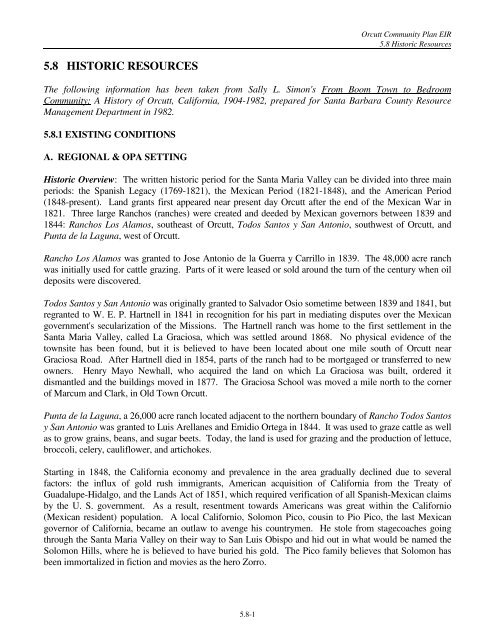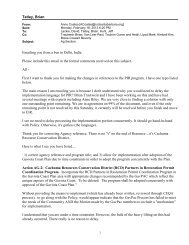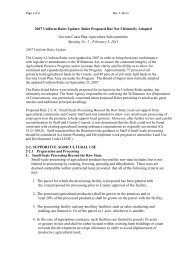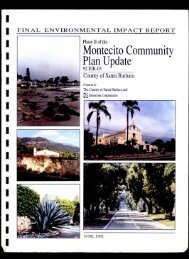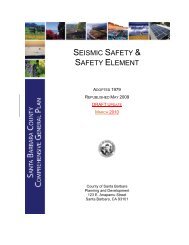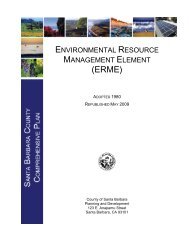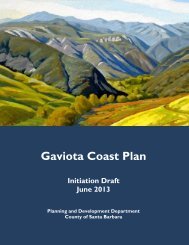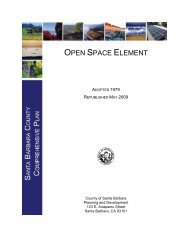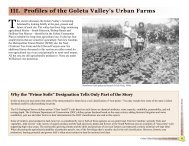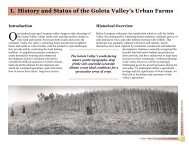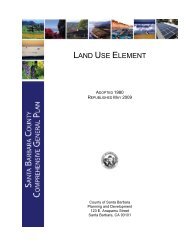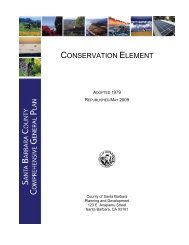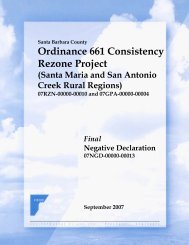5.8 HISTORIC RESOURCES - Long Range Planning Division
5.8 HISTORIC RESOURCES - Long Range Planning Division
5.8 HISTORIC RESOURCES - Long Range Planning Division
Create successful ePaper yourself
Turn your PDF publications into a flip-book with our unique Google optimized e-Paper software.
<strong>5.8</strong> <strong>HISTORIC</strong> <strong>RESOURCES</strong><br />
<strong>5.8</strong>-1<br />
Orcutt Community Plan EIR<br />
<strong>5.8</strong> Historic Resources<br />
The following information has been taken from Sally L. Simon's From Boom Town to Bedroom<br />
Community: A History of Orcutt, California, 1904-1982, prepared for Santa Barbara County Resource<br />
Management Department in 1982.<br />
<strong>5.8</strong>.1 EXISTING CONDITIONS<br />
A. REGIONAL & OPA SETTING<br />
Historic Overview: The written historic period for the Santa Maria Valley can be divided into three main<br />
periods: the Spanish Legacy (1769-1821), the Mexican Period (1821-1848), and the American Period<br />
(1848-present). Land grants first appeared near present day Orcutt after the end of the Mexican War in<br />
1821. Three large Ranchos (ranches) were created and deeded by Mexican governors between 1839 and<br />
1844: Ranchos Los Alamos, southeast of Orcutt, Todos Santos y San Antonio, southwest of Orcutt, and<br />
Punta de la Laguna, west of Orcutt.<br />
Rancho Los Alamos was granted to Jose Antonio de la Guerra y Carrillo in 1839. The 48,000 acre ranch<br />
was initially used for cattle grazing. Parts of it were leased or sold around the turn of the century when oil<br />
deposits were discovered.<br />
Todos Santos y San Antonio was originally granted to Salvador Osio sometime between 1839 and 1841, but<br />
regranted to W. E. P. Hartnell in 1841 in recognition for his part in mediating disputes over the Mexican<br />
government's secularization of the Missions. The Hartnell ranch was home to the first settlement in the<br />
Santa Maria Valley, called La Graciosa, which was settled around 1868. No physical evidence of the<br />
townsite has been found, but it is believed to have been located about one mile south of Orcutt near<br />
Graciosa Road. After Hartnell died in 1854, parts of the ranch had to be mortgaged or transferred to new<br />
owners. Henry Mayo Newhall, who acquired the land on which La Graciosa was built, ordered it<br />
dismantled and the buildings moved in 1877. The Graciosa School was moved a mile north to the corner<br />
of Marcum and Clark, in Old Town Orcutt.<br />
Punta de la Laguna, a 26,000 acre ranch located adjacent to the northern boundary of Rancho Todos Santos<br />
y San Antonio was granted to Luis Arellanes and Emidio Ortega in 1844. It was used to graze cattle as well<br />
as to grow grains, beans, and sugar beets. Today, the land is used for grazing and the production of lettuce,<br />
broccoli, celery, cauliflower, and artichokes.<br />
Starting in 1848, the California economy and prevalence in the area gradually declined due to several<br />
factors: the influx of gold rush immigrants, American acquisition of California from the Treaty of<br />
Guadalupe-Hidalgo, and the Lands Act of 1851, which required verification of all Spanish-Mexican claims<br />
by the U. S. government. As a result, resentment towards Americans was great within the Californio<br />
(Mexican resident) population. A local Californio, Solomon Pico, cousin to Pio Pico, the last Mexican<br />
governor of California, became an outlaw to avenge his countrymen. He stole from stagecoaches going<br />
through the Santa Maria Valley on their way to San Luis Obispo and hid out in what would be named the<br />
Solomon Hills, where he is believed to have buried his gold. The Pico family believes that Solomon has<br />
been immortalized in fiction and movies as the hero Zorro.
<strong>5.8</strong>-2<br />
Orcutt Community Plan EIR<br />
<strong>5.8</strong> Historic Resources<br />
Orcutt's Beginning: The economic focus of the Orcutt area soon made a major turn from farming to<br />
petroleum development. An important contributor to this shift was William Warren Orcutt, a civil and<br />
hydraulic engineer who was hired as a geologist for Union Oil in 1898. Orcutt became known as the<br />
"father of modern oil geology," as he is said to be the first person to apply the science of geology to<br />
petroleum development. His studies led to the discovery of large petroleum deposits throughout the North<br />
County region.<br />
The first commercial oil discovery in Orcutt was made by Western Union Oil Company south of Graciosa<br />
Ridge in 1900, followed by a discovery on the north side three years later. By the end of 1903, there were<br />
twenty-two oil wells in the Solomon Hills, producing about 8,000 barrels of oil per day. Oil activity in this<br />
region became so great that Orcutt selected and planned a townsite in 1904 to serve as a business center for<br />
the burgeoning oil industry. The town was named after Orcutt by E.W. Clark. It soon became the trading<br />
and supply center for the North County's Oil District, at which time included Lompoc, Bricknell, Casmalia,<br />
and Orcutt.<br />
Orcutt's heyday began in 1904 with "Old Maud," one of the biggest oil wells that anyone had ever seen.<br />
Old Maud produced 12,000 barrels of oil per day, and over one million gallons in the first 100 days. In<br />
1905 the area around the small town of Orcutt was being developed with residential and commercial units<br />
by the Twitchell, Marcum, and Gray families to accommodate the increase in population as people flooded<br />
into the area searching for work in the oil fields. By 1906 Orcutt was the largest trading center in the north<br />
county, surpassing Santa Maria. Between 1906 and 1920, Orcutt's oil production rose from 95,000 barrels<br />
to 3,742,249 barrels annually, fed by demand created by U. S. involvement in World War I. Many of the<br />
structures built during this period still exist today in Old Town Orcutt.<br />
Starting in the early 1920s, Orcutt began to develop its public electrical and sanitation services. However,<br />
during this period, productivity began to decline as a result of several factors. The end of World War I<br />
reduced the demand for food and thus farmers working to produce it. Union Oil adopted new changes in<br />
its operation, reducing its work force and causing many families to relocate. Route #2 (now Highway 101)<br />
was moved east of town, completely bypassing Orcutt, and there were several destructive fires that plagued<br />
the town. These hardships during the 1920s and 1930s caused the center of trade to move north to Santa<br />
Maria.<br />
The town of Orcutt held on through the Great Depression and exploded again in the early forties during<br />
World War II. The oil industry was temporarily stimulated by the war effort, and in the late fifties with the<br />
building of Camp Cooke, a U. S. military base, many people moved to the area and the economy began to<br />
boom again. In 1956, Camp Cooke was chosen to become a new missile training center. It was renamed<br />
Vandenberg Air Force Base in 1958. The construction of the Base thrust northern Santa Barbara County<br />
into a new era. Many of the Base's families could not be taken in by the town of Lompoc and spread out to<br />
other nearby towns, especially Orcutt. Many subdivision projects had already begun to meet the needs of<br />
the Base population during the 1950s and 60s. The population grew from 3000 in 1950 to 19,477 in 1970,<br />
concentrated in the Orcutt Wye area (a four square-mile area east of the airport).
B. EXISTING CONDITIONS BY SUB-AREA<br />
<strong>5.8</strong>-3<br />
Orcutt Community Plan EIR<br />
<strong>5.8</strong> Historic Resources<br />
Orcutt's rich and varied history has left behind numerous sites and structures that have historical<br />
significance. The historical structures on developed parcels within Old Town Orcutt are described below<br />
and shown in Figure <strong>5.8</strong>-1. Historical structures and artifacts on Key Sites are described specifically<br />
within the Key Sites Section of this EIR (Vol. II). This information is summarized below for each subarea.<br />
Central Urban Core (Old Town): Many of Old Town Orcutt's historic structures like the Graciosa School,<br />
the Orcutt School, the Orcutt Mercantile, and the Union Oil Worker's Building were destroyed by fire or<br />
torn down to build modern replacement buildings. The "Whiskey Row" buildings, on the north side of the<br />
100 block of Clark Avenue, were rebuilt with similar western-style false fronts after a fire consumed them<br />
(Figure <strong>5.8</strong>-1). Elmer's Bar has occupied a space on this block since 1936. Significant historic structures<br />
still remaining in their original townsite locations as shown in Table <strong>5.8</strong>-1.<br />
Of these structures, two stand out as particularly significant buildings reflecting the character of the era:<br />
O The James L. Forbes house, located on the northwest corner of Pinal Avenue and Pacific<br />
Street, was built in 1906. The two-story, white-walled house is well-kept and considered<br />
the most notable and impressive privately-built residence in Orcutt.<br />
O The Orcutt Hotel (now called the Orcutt Trading Center), located on the northwest block of<br />
Clark and Broadway, was built around 1922. <strong>Long</strong>-time residents maintain that Stephen dal<br />
Porta (the original owner), an alleged Santa Cruz bootlegger, built the hotel as an outlet for<br />
his whiskey during Prohibition.<br />
In addition, three houses built by Standard Oil Company are located at 4715, 4735, and 4755 South<br />
Blosser, north of Key Site 19 and west of Key Site 20. Key Site 13 has a historic ranch house located on<br />
Rice Ranch Road, that was moved to this site from its original location. There are many other buildings in<br />
Old Town that appear to date to the same period (1900 to 1930). Further research should be conducted to<br />
determine these structures' ages and possible significance.<br />
Central Urban Core (Key Sites): Of the Key Sites within the Central Urban Core, historic resources were<br />
found only on Key Site 17. No historic archaeological resources were found on Key Sites 18, 20, 23, 28,<br />
29 and 30. Important cultural resources could be present on the ten unsurveyed parcels (9, 24, 25, 26, 27,<br />
31, 32, 34, G, H).<br />
South Orcutt: The town of La Graciosa was established in 1868 and was located somewhere in the<br />
Solomon Hills. The townsite has yet to be relocated, but several historical archaeological sites have been<br />
discovered in the southern portion of the Orcutt <strong>Planning</strong> Area. The Solomon Hills contain Hartnell Well<br />
No. 1 (Old Maud), located on Union Oil Company property southwest of Key Site 12 east of Graciosa<br />
Road.
Figure <strong>5.8</strong>-1<br />
<strong>5.8</strong>-4<br />
Orcutt Community Plan EIR<br />
<strong>5.8</strong> Historic Resources
TABLE <strong>5.8</strong>-1: OLD TOWN <strong>HISTORIC</strong> BUILDINGS<br />
<strong>5.8</strong>-5<br />
Orcutt Community Plan EIR<br />
<strong>5.8</strong> Historic Resources<br />
APN LOCATION <strong>HISTORIC</strong> USE/NEW USE YEAR<br />
BUILT<br />
105-094-006 NW Union & Pacific Orcutt Church/Heritage House Antiques 1907<br />
105-131-001 SW Pinal & Pacific Boiler Works Building/ Little People<br />
Preschool<br />
1910<br />
105-071-013 NW Clark & Broadway Bank Building/ABC Realty 1920<br />
105-093-015 SW Union & First Union Oil Co. Hospital/Trophy Building
<strong>5.8</strong>-6<br />
Orcutt Community Plan EIR<br />
<strong>5.8</strong> Historic Resources<br />
remnants of turn-of-the-century residential occupations associated with oil exploration. Key Site 14 has<br />
two historic sites: SBa 1970H and 2122/H. Key Sites 4, 5, 6, 7, 8, 11, A, B, & F which were surveyed<br />
previously and Key Sites 1, 2, 10, and 11 which were surveyed in 1995, do not contain above ground<br />
cultural resources, and are unlikely to contain such resources below the ground surface.<br />
West Orcutt: Key Site 21 contains historic site SBa 1169H, which is the remains of a late 19 th or early 20 th<br />
century occupation and SBA 596/H which is a mixed historic and prehistoric site. Other sites may also<br />
occur on Site 21, as only a portion of the site has been surveyed. There is one recorded historic site west of<br />
Key Site 21. Key Site 22 contains 8 historic archaeological sites and 10 isolated artifacts. Portions of Key<br />
Sites 19, D, and E were surveyed prior to 1995 and no cultural resources were found. Key Sites 13, 15, and<br />
16 have not been surveyed and may contain cultural resources, as could Key Site D.<br />
East of Highway 101: No historic archaeological sites have been located east of Highway 101, but the<br />
area has not been surveyed. Existing historic structures are limited to the following: The Newlove<br />
Mansion, Pleasant Valley Schoolhouse, and Paulding House, which were built in the early 1900s, are now<br />
located east of Highway 101 at Santa Maria Way. They were moved from their original locations in Old<br />
Town Orcutt to save them from demolition. The owner, Dr. Roger Ikola, has proposed to create a historical<br />
park out of these three and other historical structures.<br />
<strong>5.8</strong>.2 THRESHOLDS OF SIGNIFICANCE<br />
As found in the County of Santa Barbara Historic Element, a significant resource a) possesses integrity of<br />
location, design, workmanship, material, and/or setting; b) is at least fifty years old; and c) demonstrates<br />
one or more of the following: association with historic events, architecture, construction, traditional<br />
lifeways, historic themes, or conveyance of a time and place.<br />
Potentially significant impacts on historic resources are considered to be present when the historic character<br />
and integrity of a resource may be diminished as a result of development policies included in this plan. The<br />
historic character and integrity of a resource is considered to be inclusive of all visual qualities that<br />
establish its links to historic associations, including architectural style and the historic uses of land,<br />
structures, and setting. On a parcel-specific basis, potentially significant environmental impacts are<br />
considered to be present when the proposed policies and land use designations:<br />
a) represent a change from a historic use of a structure or property,<br />
b) encourage an increase in development densities, or<br />
c) permit alterations to the historic character of land uses or structures.
<strong>5.8</strong>.3 IMPACT ANALYSIS<br />
Methodology<br />
<strong>5.8</strong>-7<br />
Orcutt Community Plan EIR<br />
<strong>5.8</strong> Historic Resources<br />
The historic information for this document was acquired from two documents prepared by the Orcutt<br />
Historical Society (Nelson 1987 & Simon 1990). The County conducted a record search at the Information<br />
Center at UCSB in 1995, and historic records and maps housed at the UCSB Library Maps and Imagery<br />
Laboratory were examined. A professional archaeological (historic and prehistoric) field survey was<br />
conducted by ISERA Group for the County in 1995. The field survey was conducted by traversing the<br />
developable areas of certain Key Sites at 15 meter transects and recording and mapping information about<br />
resources that were found. The results of this survey are summarized below. Specific information<br />
regarding historical sites has been intentionally left out of this EIR in order to protect the resources from<br />
pilferage and vandalism. The technical report (ISERA Group, 1995) is on file at the County and at UCSB<br />
and is not available to the general public.<br />
A.Project Impacts<br />
Impact HIST-1: Construction of structures, roads, paths and trails, utility lines, and parks on historic sites<br />
could result in destruction of historic resources which is potentially significant.<br />
Impact HIST-2: Development in the Solomon Hills where Old Maud and the Newlove Schoolhouse still<br />
stand, and where the remains of former residences lay scattered, could have a potentially significant impact<br />
on their integrity by removing them from their historical context or significantly altering their surroundings.<br />
Impact HIST-3: Removal of historically significant and prominent structures in the Old Town would<br />
remove the last remaining historical structures that mark the beginning of this community and is a<br />
potentially significant impact.<br />
Impact HIST-4: The construction of homes and other structures that are not consistent with the density<br />
and style of the remaining historic structures could have a potentially significant impact the historic<br />
character of the Old Town.<br />
B.Policy Impacts<br />
The proposed Community Plan does not contain any policies applicable to the protection of historical<br />
resources.<br />
<strong>5.8</strong>.4 MITIGATION MEASURES<br />
The following mitigation measures shall be applied to public and private development projects pursuant to<br />
the Santa Barbara County historical guidelines, the State Office of Historic Preservation. All mitigation<br />
measures shall be funded by the developer, and imposed prior to the issuance of a development permit.<br />
Site-specific mitigation measures are stated in the Key Sites Section (Volume II) for Key Sites where more<br />
specific measures are required. These mitigation measures require avoidance of impacts. However, where
<strong>5.8</strong>-8<br />
Orcutt Community Plan EIR<br />
<strong>5.8</strong> Historic Resources<br />
avoidance is not feasible, alternate measures may be available which could mitigate the impact to<br />
insignificant levels, eg: Phase II evaluation, capping the site, etc.<br />
A. Mitigation Measures<br />
Mitigations ARCH-1 and ARCH-2 shall apply. (Addresses Impact HIST-1)<br />
Mitigations ARCH-3, -4, -6, -7, -8 and -10 shall apply to all development where historic sites are located<br />
if avoidance is not feasible. (Addresses Impact HIST-1)<br />
Mitigation HIST-1: Any significant impact to historic resources in the rural area that cannot be feasibly<br />
mitigated onsite should be mitigated by providing improvements to the character and integrity of Old<br />
Town. (Addresses Impact HIST-1)<br />
Mitigation HIST-2: The Open Space Overlay (Figure 2-14) shall be applied in a manner that preserves<br />
the historical context of the Solomon Hills to the greatest extent feasible. (Addresses Impact HIST-2)<br />
Mitigation KS12-ARCH-2 shall be applied to Key Site 12. (Addresses Impact HIST-2)<br />
Impacts HIST-3, HIST-4 and HIST-5:<br />
Mitigation HIST-3: In cooperation with private citizens, the County shall establish a Historic District in<br />
Old Town Orcutt with the intent of protecting, restoring the community's most valuable historic homes<br />
through a combination of incentives and regulations, and maintaining and enhancing the overall historic<br />
character of the old town. The boundaries of this district should be North Avenue, Gray Street, Clark<br />
Avenue, Highway 135, Pinal Avenue, Dyer Street, Rice Ranch Road, and Marcum Street (Figure <strong>5.8</strong>-1).<br />
(Addresses Impacts HIST-3, -4, and -5).<br />
Mitigation HIST-4: As funding becomes available, the County should adopt an ordinance or modify<br />
Section 35-243.1 of Article III of the County Zoning Ordinance in order to prevent demolition of<br />
historically significant structures by neglect, and avoid demolition without examining alternative methods<br />
for preserving the structure such as finding another location. The ordinance should require, prior to<br />
issuance of a Land Use or Building Permit to demolish or modify the structure, the applicant shall be<br />
required to prepare a Phase I historical architectural building evaluation for all structures over 50 years<br />
old(Addresses Impacts HIST-3, -4, and -5).<br />
<strong>5.8</strong>.5 RESIDUAL IMPACTS<br />
Implementation of the mitigation measures will reduce the impact to historic sites and structures to Less<br />
than Significant (Class II).


